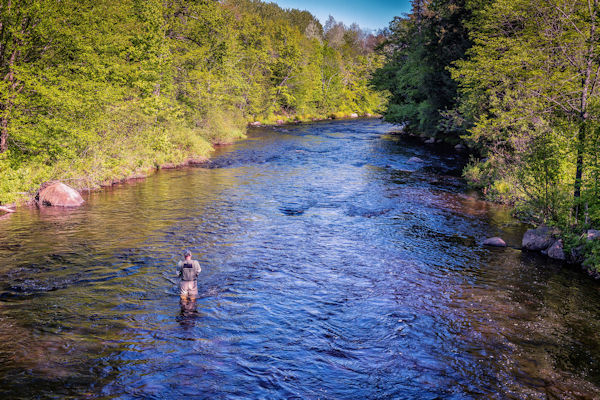SEJournal Online is the digital news magazine of the Society of Environmental Journalists. Learn more about SEJournal Online, including submission, subscription and advertising information.
 |
| Stream temperature is a critical variable for all kinds of trout and salmonids, but climate change will warm some streams, eventually shrinking fisheries in parts of the United States. Above, fly fishing in the Adirondacks. Photo: Mobilus in Mobili, Flicker Creative Commons. Click to enlarge. |
Reporter’s Toolbox: Angling for Stories on Streams Suffering From Climate Change? Try Trout
By Joseph A. Davis
Trout fishers know that those wild brookies with their jewel-like colors are a rare and breathtaking treasure. But could climate change cause them to disappear from favorite streams?
It turns out there’s a database to help report on this. The U.S. Geological Survey, or USGS, collects stream temperature data and makes it available free online.
What’s the connection? Fishers know that stream temperature is a critical variable for all kinds of trout and salmonids. Trout like cold water, but climate change will warm some streams, eventually shrinking trout fisheries in parts of the United States.
But the USGS database is not only helpful to fishers. Environmental journalists can make good use of it as well. And with fishing season already underway in many parts of the country, it may be a story of current interest to your audience.
Where the data comes from
The USGS gets its data from an extensive network of stream and lake monitoring stations throughout the United States, which collect streamflow, temperature and other data, often in real time.
The bad news is that
temperatures are rising in
some 65 percent of U.S. streams.
The one overview access point is the USGS National Water Dashboard, which leads to most available data resources. That means some 13,000 USGS stream, lake, reservoir, precipitation, water quality and groundwater stations. The bad news is that temperatures are rising in some 65 percent of U.S. streams.
It’s a nifty tool for lots of environmental journalism projects. But a cautionary note: Fishers know that they are fishing a whole ecosystem, of which the stream is a kind of summation. A lot of things can ruin a stream, and even more can ruin a good fishing day. Many threaten to ruin a stream faster than climate could — including housing development, paving of watershed surfaces, groundwater depletion, nutrients and eutrophication, erosion and sedimentation, and bad chemicals that kill bugs.
That’s just for starters. Flow and temperature — which are connected, as climate may change precipitation amount and timing — vary widely over the course of a year or season. Fish migrate in response to seasons, which is sometimes why you can’t find them.
How to use the data smartly
Still, the connection between climate change and stream temp is important enough that many scientists have studied it. Fishers study their reach, or small section, of a stream. But as a journalist, you zoom back to a wider view. How will climate change warm your region’s streams, perhaps ruin fishing or hurt your local outdoor recreation and tourism economy? It’s worth asking.
Sadly, stream temperature is not available at every station. Happily, some other parameters of importance to fishers and journalists (like dissolved oxygen) are available at some stations. You can usually get trend data over quite a few years if the station has been there for a while. This is how you can find year-to-year increases.
You don’t have to do all the science yourself. Look around in your area for researchers in hydrology, fish biology, limnology and other relevant disciplines, at universities, government research labs, state and national forests, refuges and parks.
A nearby fish hatchery might also lead you in the right direction. Or ask local fishing guides. Does your river have a conservancy of some kind? A Trout Unlimited or Izaak Walton League chapter? A riverkeeper?
Scientists have actually been studying the potential effect of climate change on coldwater fisheries for years — whether or not they have scrutinized your favorite stream. You can find some studies referenced by Scientific American's EarthTalk, the USDA, the Ausable River Association, the American Geophysical Union's Water Resources Research, Trout Unlimited and the USGS itself.
Joseph A. Davis is a freelance writer/editor in Washington, D.C. who has been writing about the environment since 1976. He writes SEJournal Online's TipSheet, Reporter's Toolbox and Issue Backgrounder, as well as compiling SEJ's weekday news headlines service EJToday. Davis also directs SEJ's Freedom of Information Project and writes the WatchDog opinion column and WatchDog Alert.
* From the weekly news magazine SEJournal Online, Vol. 6, No. 17. Content from each new issue of SEJournal Online is available to the public via the SEJournal Online main page. Subscribe to the e-newsletter here. And see past issues of the SEJournal archived here.












 Advertisement
Advertisement 



